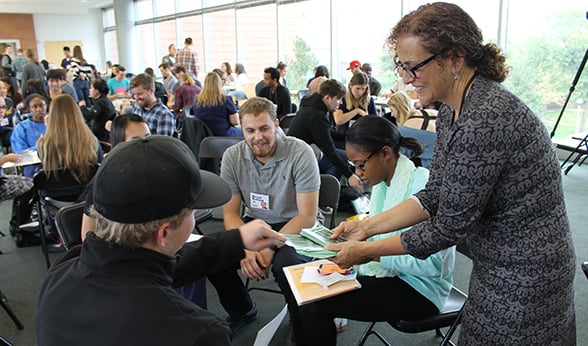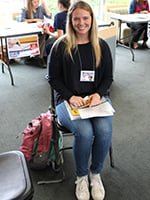In under an hour, Margaret, 57, a grandmother who suffered a stroke and is partially paralyzed, lost her foods stamps, faced eviction from her home and was robbed of her jewelry and valuables. These events left her and her son, Miles, 36, his wife, Melinda, 36, and their daughter, Mandy, 15, confused, frustrated and worried.
This was no ordinary family. First-year CU School of Dental Medicine students took on these roles during the first-ever Poverty Simulation, a three-hour session in which they experienced the same struggles as real low-income families. Having the time and money for dental and health care was often last on the list as these families worked to pay rent, buy food and take care of their children.
“My family is out working or looking for work and it’s kind of frustrating because I’m paralyzed and I have to stay here and can’t help more,” says dental student Rebecca Ryan, 24, who played Margaret, the family matriarch. “But that’s the reality of life – it can change in a second and that’s what happened to Margaret.”
The Poverty Simulation is part of Community Engagement I, a fall class that introduced 81 first-year dental students to public dental health, says William D. Bailey, DDS, MPH, CU School of Dental Medicine Chair, Department of Community Dentistry and Population Health.
“We want our students to be aware of the barriers and inequities in accessing dental and health care,” says Bailey, adding that the hands-on Poverty Simulation experience is more powerful than any lecture.
The goals of the simulation were to raise students’ awareness of the realities of poverty, while helping them understand stereotypes and misconceptions about low-income families, says Deidre Callanan, RDH, DC, MPH, a CU School of Dental Medicine Clinical Instructor, Community Engagement.
“The hope is that students now understand some of the barriers and frustrations to accessing services, including health and dental care for those with limited resources,” Callanan says. “We want our students to graduate with a deeper understanding, respect and compassion for their patients while they are out in the community, in the school clinics and when they become practicing dentists.”
How the simulation works
At the start of the Poverty Simulation, students received packets and worked in groups as makeshift families. The packets provided them descriptions of family members, their ages, employment situation, health status, income and monthly bills. Some families owned vehicles; others could only use bus passes to get where they needed to go.
Their tasks? They had to provide food, shelter and basic necessities for a month. They also received information on resources that would help them survive. About 20 community volunteers represented various agencies that could provide services for these families – from food and rent assistance to childcare. Each 15 minutes of the simulation represented a week in their lives.
There also was a bank, an employer, a juvenile detention center, utility and mortgage companies, a pawnshop, and a health care clinic, among other businesses and agencies.
 Dr. Deidre Callanan hands out fake money, bus passes and other materials to dental students participating in the poverty simulation.
Dr. Deidre Callanan hands out fake money, bus passes and other materials to dental students participating in the poverty simulation.
The students represented four different types of families during the simulation. They included a family of four or five; some had two parents and others were single parents with children. Some students posed as elderly single people with health issues and little family support.
Dental student Ryan Koster, 22, was surprised to find out he was a pregnant 16-year-old girl.
“I’m due in two months, we just got evicted and I’m not doing too hot,” says Koster, adding that he’s had no access to health care. “It’s crazy, it’s eye-opening. It’s a lot more interactive than I thought. This experience has helped me understand different people and situations. This will make me a better dentist.”
A family in crisis
For the family of Margaret, Miles, Melinda and Mandy, the struggles resonated with the dental students who played their parts.
 Dental student Rebecca Ryan played the role of "Margaret," the family matriarch, in the poverty simulation.
Dental student Rebecca Ryan played the role of "Margaret," the family matriarch, in the poverty simulation.
“It definitely gives you a different perspective of how people live,” says Hassanain Zaheer, 23, who was15-year-old Mandy. “This simulation helps us understand the hoops people have to go through. This is the first time I’ve done anything like this – it’s a unique experience.”
Stanford Smith, 29, who represented Miles, the father, said he gained new insight as the only wage earner in a large family.
“I didn’t know what we were going to do – it was hard to get things done and you had to learn to work the system,” he says. “It was so frustrating because you’re trying to do everything, but the lines were long and you couldn’t get stuff done.”
He says the experience helped him understand the complexities low-income families face every day.
“This is a great program – it really made me see what it’s like to live on minimum wage,” he says. “It makes me want to do more and help the people I see as patients.”
While her “family” faced challenging life situations and tough decisions, Messay Ibrahim, 25, said she didn’t realize life could be so difficult.
“As Melinda, I’m unemployed and I tried to get a job, but I couldn’t,” she said. “It was just so hard trying to pay our bills and we still got evicted. We just had so many things thrown at us.”
She says the experience will make her a better dentist.
“It helps us to know where our patients are coming from and all the emotions and stress that comes with living in poverty,” she says. “The one thing I did like was that our family did try to work together to overcome all our challenges – and I’m thankful for that.”




